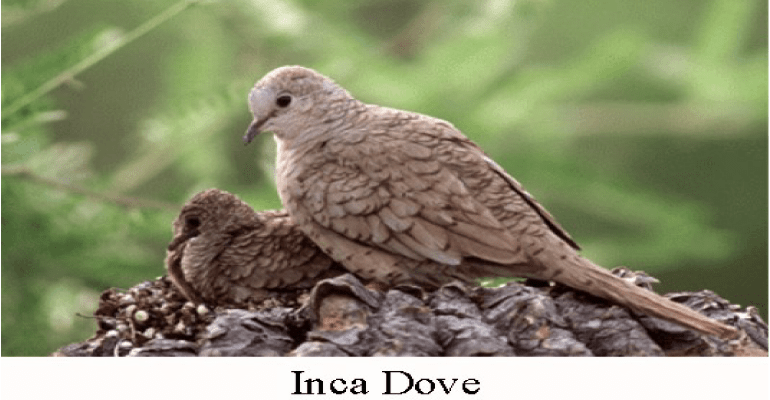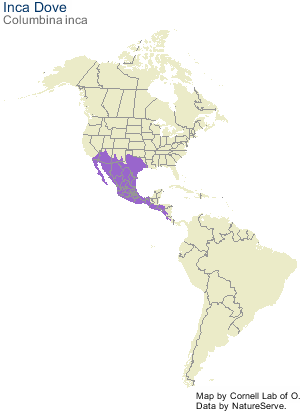
The Inca Dove (Columbina inca) is a small dove with a body length of about 8 inches. It is smaller than a Mourning dove and the White-winged dove. The Inca Dove’s color is light brownish gray and has a scaled appearance on its back. The tail is slender and has white sides. At rest, this dove is very dull looking. That changes in flight or when the dove is displaying. Then the bright rufus-colored primaries on the underside of the wings are visible. Male doves use the display of raising one wing over their backs to defend their territory against other males. During courtship, the male bobs its head, raises its tail high over back and spreads it widely to show off black and white markings.

Inca doves occur in the southwestern U.S. and most of Mexico. They are found around human settlements throughout much of the Sonoran Desert region. They seem to prefer open areas with sparse shrub cover and scattered trees such as palo verde and oak.
They are seed and fruit eaters. Doves grind seeds in their muscular stomachs (or gizzards) using sand or gravel much like internal teeth.
According to the Arizona-Sonora Desert Museum, “The Inca Dove has the longest breeding season of any Arizona bird: January to November. That fact, plus its preference for grass and weed seeds, have made the Inca Dove the most abundant bird in southwestern urban areas, after the house sparrow.”
According to Audubon, Nest sites vary, usually in trees or shrubs 5-20 feet above ground, sometimes as high as 50 feet. Nests (built by female, with material gathered by male) are a small platform of twigs, stems, leaves, sometimes lined with grass.
Both parents incubate the eggs for about two weeks. Upon hatching, the chicks are fed “pigeon milk” produced by both parents. “Both males and females produce this substance in their crops (the pouch just above the stomach that birds use to store food). The walls of the crop swell with fat and proteins until the cells in the crop wall begin shedding, producing a nutritious, milky-colored secretion. Despite its appearance, it’s not related to the milk produced by mammals.” – (Cornell)
The chicks fledge within two weeks of hatching and may be tended by the parents for another week or two.
Inca doves have a distinct sound. Listen here. Do you recognize it?
See also:
Note to readers:
- Index with links to all my ADI articles: http://wp.me/P3SUNp-1pi
- My comprehensive 28-page essay on climate change: http://wp.me/P3SUNp-1bq
- A shorter ADI version is at https://arizonadailyindependent.com/2013/08/01/climate-change-in-perspective/
If you like murder mysteries, type the name Lonni Lees (my wife) into Amazon or Barnes & Noble sites to see her novels, a book of short stories, and reviews. For synopses and more reviews of her books see: https://wryheat.wordpress.com/lonnis-murder-mysteries/
